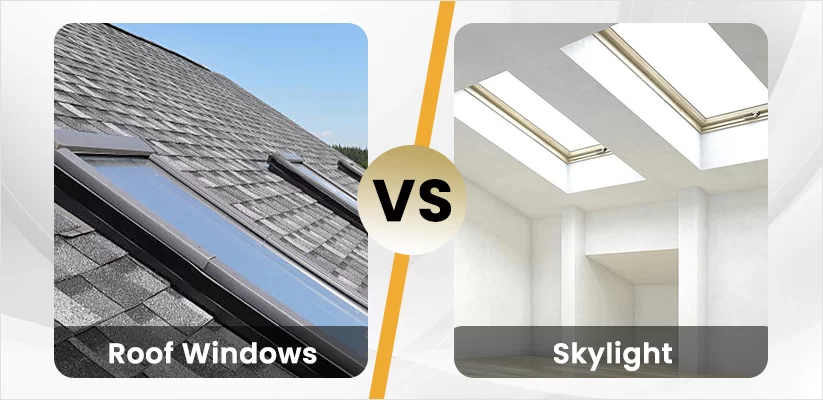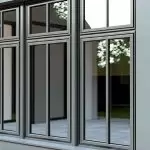When it comes to the installation of roof windows or skylights we always wonder which one should we go for, and soon it becomes a competition between roof windows vs skylights because they have many similarities, the roof windows and skylights both have the function of introducing natural light into the interiors and brighten up the space. They are widely used in areas where it is not possible to introduce light through windows, especially in areas like corridors, attics, store rooms etc. They can be confused with each other.
Post your Requirement
Bringing natural light and ventilation into our homes, roof windows and skylights have become increasingly popular choices. Both options offer unique benefits, but understanding their differences and advantages is crucial to make an informed decision for your specific needs. In this blog, we’ll explore the characteristics and features of roof windows and skylights to help you determine the perfect solution for your home.
Understanding Roof Windows
Roof windows, also known as rooflights or roof lanterns, are installed flush with the roof surface and are hinged at the top, allowing them to open and close. They come in various designs, including fixed windows, manually operated, fixed and electrically controlled options. Roof windows are an excellent choice for attics, lofts, or any room with sloped ceilings.
-
Natural Light:
Roof windows provide an abundant amount of natural light due to their size and positioning. They are particularly effective in areas with limited access to sunlight, making them ideal for dark or poorly lit spaces.
-
Ventilation:
One of the key advantages of roof windows is their ability to offer controlled ventilation. You can open them to varying degrees to let fresh air circulate through your rooms, promoting a healthier indoor environment.
-
Aesthetics:
Roof windows add a touch of elegance to your home’s interior and exterior. They offer unobstructed views of the sky and surrounding landscape, contributing to a more spacious and inviting atmosphere.
-
Privacy and Glare:
Roof windows are often equipped with blinds or shades, allowing you to control privacy and reduce glare from the sun when needed.
Understanding Skylights
Skylights, on the other hand, are windows installed in the roof, but they are fixed and cannot be opened. They are available in different shapes and sizes and are commonly used in rooms with flat ceilings or where roof windows may not be suitable.
-
Natural Light:
Skylights are designed to maximize natural light and can illuminate a room more evenly compared to standard vertical windows. They work exceptionally well in areas with high ceilings or where wall space is limited.
-
Energy Efficiency:
With appropriate glazing options, skylights can enhance energy efficiency by reducing the need for artificial lighting during the day.
-
Rain and Debris:
One concern with skylights is that they are prone to accumulate dirt, debris, and condensation, which may affect visibility over time. Regular cleaning and maintenance are essential to keep them in good condition.
-
UV Protection:
High-quality skylights come with UV-resistant coatings, protecting your furniture and interiors from sun damage.
Choosing the Right Option
The decision between a roof window and a skylight ultimately depends on your specific requirements and the characteristics of the space you want to improve. Roof windows and skylights are both architectural elements designed to bring natural light into buildings, but they have some key differences in their functionality, installation, and features. Let’s explore these differences to understand how each option can benefit your home:
-
Operation and Ventilation:
Roof Window: Roof windows designed to be operable, meaning they can be opened and closed. This feature allows for controlled ventilation, making them suitable for rooms where fresh air circulation is desired, such as bedrooms, kitchens, or attics.
Skylight: Skylights, on the other hand, are fixed and cannot be opened. They are primarily meant to provide natural light and a view of the sky but do not offer ventilation options.
-
Placement and Design:
Roof Window: Typically, roof windows are installed flush with the roof surface and are hinged at the top. They have a more horizontal orientation and are often used on sloped or pitched roofs. Roof windows can vary in size, and some models may have a larger opening area.
Skylight: Skylights are installed on the roof and have a more vertical orientation. They can be used on both sloped and flat roofs. Skylights are available in various shapes, such as rectangular, square, circular, or even custom designs, allowing for more flexibility in architectural design.
-
Natural Light Distribution:
Roof Window: Due to their horizontal orientation, roof windows tend to distribute natural light more evenly throughout the room. They can illuminate a larger area and are particularly effective in rooms with limited access to daylight.
Skylight: Skylights can bring in intense, focused light, especially when the sun is directly overhead. However, their light distribution may be more concentrated around the opening, which can create dramatic effects and highlight specific areas of the room.
-
Energy Efficiency:
Roof Window: Some roof window models come with advanced glazing options and insulation materials, making them energy-efficient and helping to prevent heat loss during colder months.
Skylight: Skylights can also be energy-efficient, especially if they are equipped with double or triple glazing, low-emissivity (Low-E) coatings, and thermal breaks to reduce heat transfer.
-
Cost:
Roof Window: Generally, roof windows tend to be more expensive than skylights due to their operable features, which add to their complexity and functionality.
Skylight: Skylights are usually more cost-effective as they are fixed and have a simpler design compared to operable roof windows.
-
Installation:
Roof Window: Installing a roof window may require more expertise and effort, especially if the window is operable. Proper sealing and waterproofing are crucial to prevent leaks.
Skylight: Skylights are relatively easier to install, especially the fixed ones, but they still require proper installation to ensure they are watertight and weather-resistant.
Conclusion
The main difference between roof windows and skylights lie in their operability, orientation, and light distribution. Roof windows offer the advantage of ventilation and a more even distribution of natural light, while skylights are fixed and provide concentrated lighting effects. Your choice between the two will depend on your specific needs, the room’s function, and your budget. Both options can transform your living spaces, bringing the beauty of the outdoors inside while creating a more pleasant and inviting environment in your home. Assess your needs, your budget, and the characteristics of your space to make an informed decision.























Post A Comment